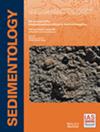A clumped isotope diagenetic framework for the Ediacaran dolomites: Insights to fabric‐specific geochemical variabilities
IF 2.8
2区 地球科学
Q1 GEOLOGY
引用次数: 0
Abstract
ABSTRACT While marine dolomites formed under near surface conditions have been considered to be potentially reliable archives of past oceanic conditions, this interpretation comes with significant challenges because diagenetic alteration frequently produces diverse fabrics with large geochemical variability. It has been suggested that the Ediacaran dolomites in South China (Hamajing Member, Dengying Formation) recorded the oceanic conditions present at the time they formed, yet these dolomites are composed of five different fabrics (stromatolitic, micritic, oolitic, saddle dolomites and fibrous–radial dolomite cements) and show large variations in multiple geochemical isotope proxies (carbon, oxygen, clumped, magnesium and the sulphur of carbonate‐associated sulphate). This study establishes a paragenetic sequence for these dolomites by combining the clumped and the oxygen isotopic compositions, thereby assessing whether they are geochemically representative of the original seawater. Using this diagenetic framework, the micritic and stromatolitic dolomites show a closed‐system behaviour (low water–rock ratios; <0.3) and are largely resistant to the hydrothermal alteration during late diagenesis. In contrast, the ooid and cement fabrics have been affected by the hydrothermal fluid precipitating saddle dolomite in the open‐system condition with the high stimulated water–rock ratios (>1). Furthermore, in a closed‐system environment, the elevated δ 24 Mg and δ 34 S values in the stromatolitic dolomite reflect the isotopic Rayleigh fractionation that enriches the 26 Mg and 34 S through rock‐buffered recrystallization, coupled with microbial sulphate reduction. These results demonstrate that the complex signals in early marine dolomite should be carefully evaluated when used as a palaeoproxy.埃迪卡拉系白云岩的块状同位素成岩格架:对构造特异性地球化学变异的见解
虽然在近地表条件下形成的海相白云岩被认为是过去海洋条件的潜在可靠档案,但这种解释面临着重大挑战,因为成岩蚀变经常产生具有大地球化学变异性的不同结构。华南埃迪卡拉系(灯影组哈马井段)白云岩在形成时记录了海洋条件,但这些白云岩由五种不同的结构(叠层岩、泥晶岩、鲕粒岩、鞍状白云岩和纤维-放射状白云岩胶结物)组成,并在多种地球化学同位素指标(碳、氧、块状、镁和碳酸盐伴生硫酸盐的硫)上表现出很大的变化。本研究结合白云岩的团块和氧同位素组成,建立了白云岩的共生序列,从而评估其是否具有原始海水的地球化学代表性。利用这一成岩格架,泥晶白云岩和叠层岩白云岩表现出封闭的系统行为(低水岩比;<0.3),并且在很大程度上抵抗晚期成岩过程中的热液蚀变。相比之下,在高水岩比(>1)的开放体系条件下,水热液沉淀鞍状白云岩对流体和水泥结构的影响较大。此外,在封闭系统环境下,叠层石白云岩中δ 24 Mg和δ 34 S值的升高反映了同位素瑞利分馏作用,该分馏作用通过岩石缓冲再结晶和微生物硫酸盐还原使26 Mg和34 S富集。这些结果表明,早期海相白云岩的复杂信号在作为古代用物时应慎重评价。
本文章由计算机程序翻译,如有差异,请以英文原文为准。
求助全文
约1分钟内获得全文
求助全文
来源期刊

Sedimentology
地学-地质学
CiteScore
8.20
自引率
11.40%
发文量
94
审稿时长
6-12 weeks
期刊介绍:
The international leader in its field, Sedimentology publishes ground-breaking research from across the spectrum of sedimentology, sedimentary geology and sedimentary geochemistry.
Areas covered include: experimental and theoretical grain transport; sediment fluxes; modern and ancient sedimentary environments; sequence stratigraphy sediment-organism interaction; palaeosoils; diagenesis; stable isotope geochemistry; environmental sedimentology
 求助内容:
求助内容: 应助结果提醒方式:
应助结果提醒方式:


